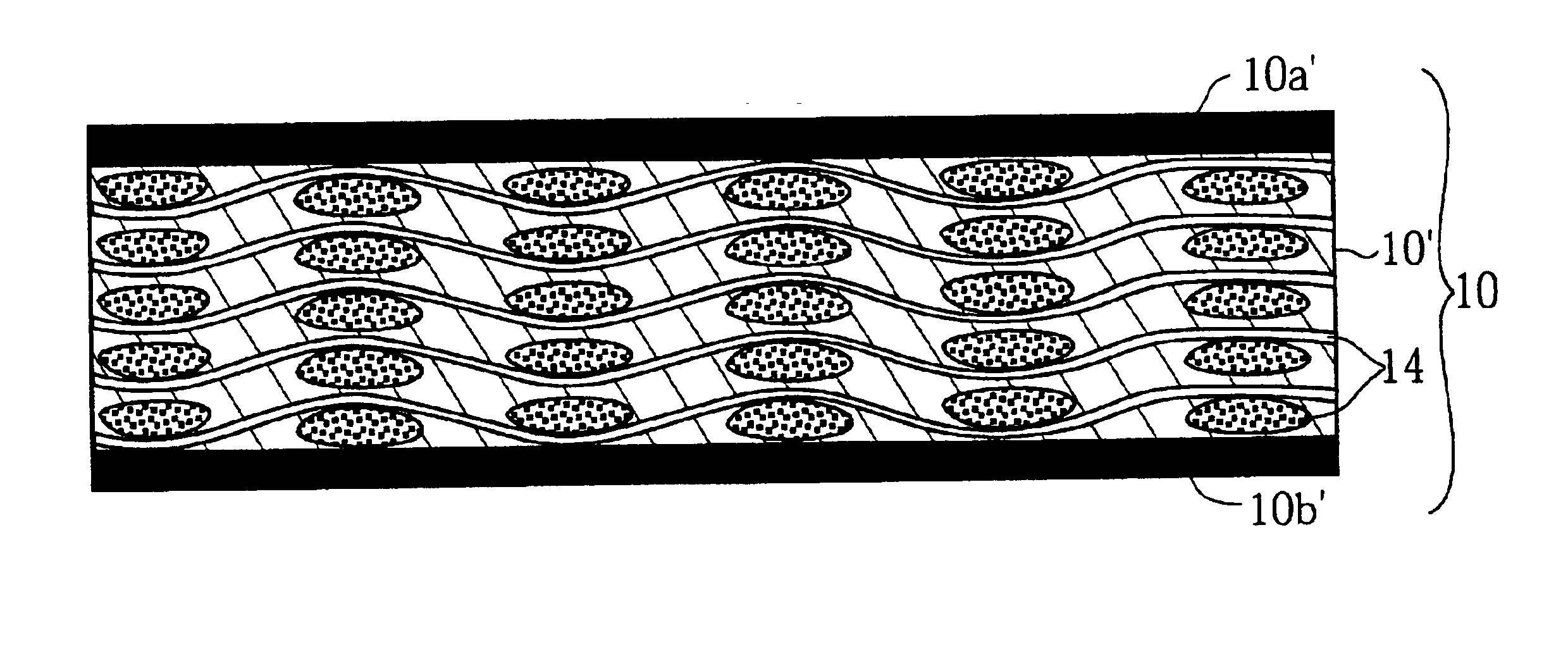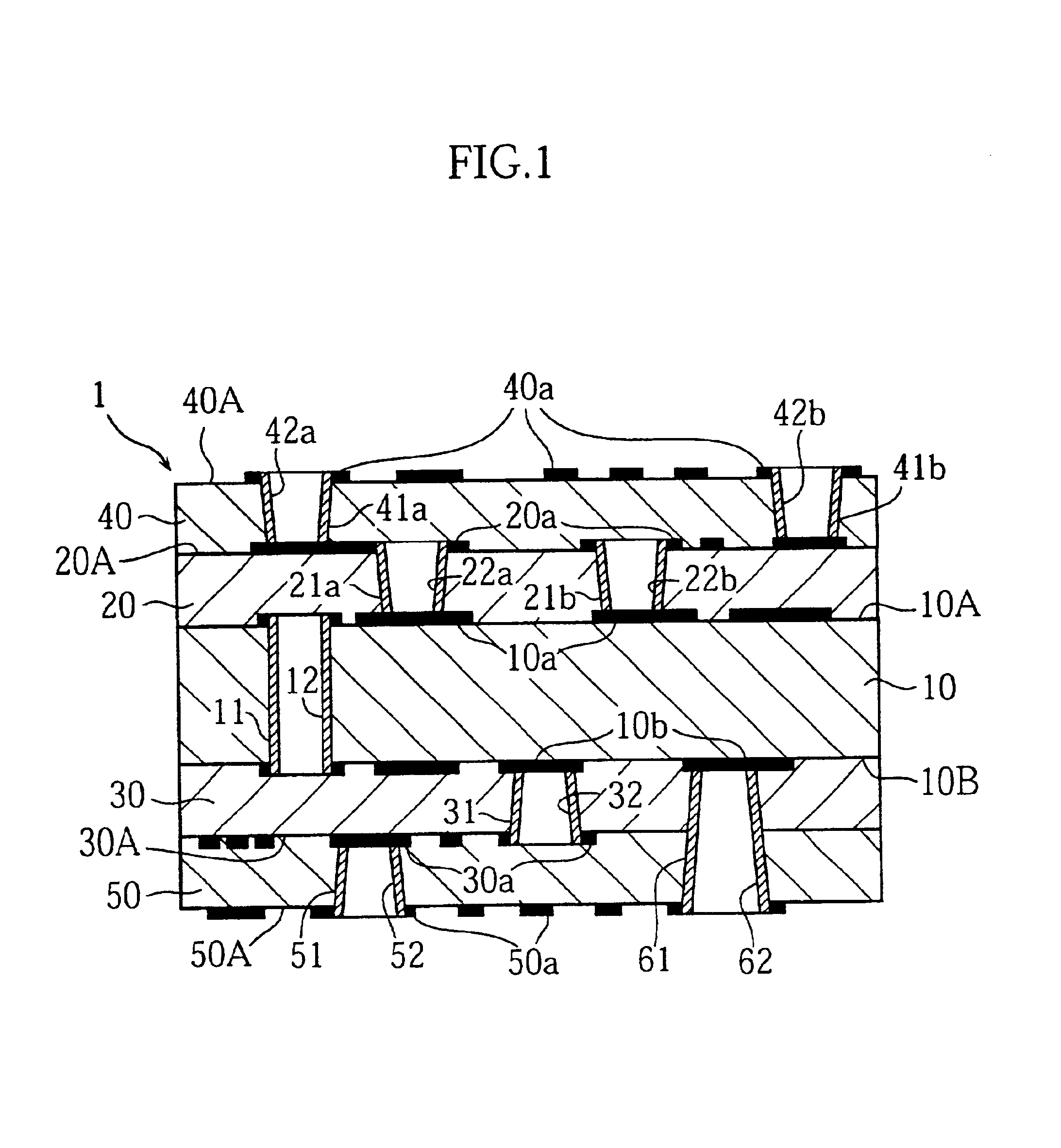Multilayer printed wiring board
a multi-layer printed, wiring board technology, applied in weaving, applications, other domestic objects, etc., can solve the problems of increasing the likelihood of glass cloth drill bit breakage, difficult to reduce the thickness of multi-layer printed wiring boards, and difficulty in increasing the density of each wiring pattern, so as to increase the contact area, increase the elastic modulus, and enhance the adhesion of resin
- Summary
- Abstract
- Description
- Claims
- Application Information
AI Technical Summary
Benefits of technology
Problems solved by technology
Method used
Image
Examples
embodiment 1
[Measurement of Elastic Modulus]
In Embodiment 1, use was made of a core member (Tradename: H-32, Supplier: Showa Denko K. K) which had a thickness of 0.4 mm and a workpiece size of 340×510 mm. The core member contained 50 volume % of glass cloth. The core member was a laminate of prepregs each prepared by impregnating a glass cloth (E-glass) with an epoxy resin, and attaching copper foils to the opposite surfaces of the prepreg laminate. The glass cloth comprised filaments each having a diameter of 5 μm. The epoxy resin contained, as dispersed therein, powder of aluminum hydroxide having an average particle size of 3.8 μm. Each of the copper foils had a thickness of 18 μm.
Further, epoxy resin sheets (Tradename: ABF-SH, Supplier: Ajinomoto Co., Inc.) were used as insulating films for forming buildup layers. Each of the resin sheets had a thickness of 50 μm.
The bending elastic modulus of the core member was measured by the three-point bending method using an elastic modulus measuring ...
embodiment 2
[Measurement of Elastic Modulus]
In Embodiment 2, use was made of a core member which had a thickness of 0.4 mm and a workpiece size of 340×510 mm. The core member contained 45 volume % of glass cloth. The core member was a laminate of prepregs each prepared by impregnating a glass cloth with an epoxy resin, and attaching copper foils to the opposite surfaces of the prepreg laminate. The glass cloth comprised filaments each having a diameter of 7 μm. The epoxy resin contained, as dispersed therein, powder of magnesium hydroxide having an average particle size of 3 μm and powder of silica having an average particle size of 4 μm. Each of the copper foils had a thickness of 18 μm.
Further, polyimide resin sheets were used as insulating films for forming buildup layers. Each of the resin sheets had a thickness of 30 μm.
As a result of the elastic modulus measurement performed in the same way as in Embodiment 1, the core member was found to have a bending elastic modulus of 14 GPa at 240° C...
embodiments 4-12
A plurality of multilayer printed wiring boards which included 2-10 buildup layers on each surface of the respective core member were prepared in the same manner as in Embodiment 3. The respective warping amounts (maximum gaps) of these wiring boards were measured before and after the wiring boards were subjected to the reflow process ten times. The measurement results of the wiring boards including 2˜10 buildup layers are given in Table 1 as Embodiments 4˜12, respectively.
PUM
| Property | Measurement | Unit |
|---|---|---|
| elastic modulus | aaaaa | aaaaa |
| elastic modulus | aaaaa | aaaaa |
| diameter | aaaaa | aaaaa |
Abstract
Description
Claims
Application Information
 Login to View More
Login to View More - R&D
- Intellectual Property
- Life Sciences
- Materials
- Tech Scout
- Unparalleled Data Quality
- Higher Quality Content
- 60% Fewer Hallucinations
Browse by: Latest US Patents, China's latest patents, Technical Efficacy Thesaurus, Application Domain, Technology Topic, Popular Technical Reports.
© 2025 PatSnap. All rights reserved.Legal|Privacy policy|Modern Slavery Act Transparency Statement|Sitemap|About US| Contact US: help@patsnap.com



